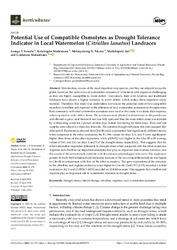| dc.contributor.author | Sewelo, Lesego T. | |
| dc.contributor.author | Madumane, Kelebogile | |
| dc.contributor.author | Nkane, Metseyabeng N. | |
| dc.contributor.author | Tait, Motlalepula | |
| dc.contributor.author | Malambane, Goitseone | |
| dc.date.accessioned | 2024-06-14T08:34:45Z | |
| dc.date.available | 2024-06-14T08:34:45Z | |
| dc.date.issued | 2024-05 | |
| dc.identifier.citation | Sewelo, L. T., Madumane, K., Nkane, M. N., Tait, M., & Malambane, G. (2024). Potential Use of Compatible Osmolytes as Drought Tolerance Indicator in Local Watermelon (Citrullus lanatus) Landraces. Horticulturae, 10(5), 475. | en_US |
| dc.identifier.issn | 2311-7524 | |
| dc.identifier.uri | 10.3390/horticulturae10050475 | |
| dc.identifier.uri | https://doaj.org/toc/2311-7524 | |
| dc.identifier.uri | https://hdl.handle.net/13049/740 | |
| dc.description | No special permission is required to reuse all or part of article published by MDPI, including figures and tables. For articles published under an open access Creative Common CC BY license, any part of the article may be reused without permission provided that the original article is clearly cited. | en_US |
| dc.description.abstract | Watermelons are one of the most important crop species, and they are enjoyed across the globe; however, the cultivation of watermelon commercial varieties in arid regions is challenging, as they are highly susceptible to water deficit. Conversely, their wild relatives and traditional landraces have shown a higher tolerance to water deficit, which makes them important study material. Therefore, this study was undertaken to evaluate the potential roles of two compatible osmolytes (citrulline and arginine) in the tolerance of local watermelon accessions to drought stress. Four commonly cultivated watermelon accessions were used in this study to evaluate their response when exposed to water deficit stress. The accessions were planted in stress boxes in the greenhouse and allowed to grow until the fourth leaf was fully open and then the water deficit stress was initiated by withholding water for a period of nine days, before rewatering for three days. Data and leaf samples were collected at three-day intervals. The common drought indicators that were assessed, like chlorophyll fluorescence, showed that Clm-08 (wild watermelon) had significantly different results when compared to the other accessions; the Fv/Fm values for days 3, 6, and 9 were significantly higher than those of the other accessions, while phiNPQ was higher in the Clm-08 with average values of 0.41 and 0.41 on days 6 and 9 of the drought stress, respectively. This suggests that the wild watermelon responded differently to drought stress when compared with the other accessions. Arginine and citrulline are important osmolytes that play an important role in stress tolerance, and the results of the current study correlate with the common physiological indicators. The expression pattern for both the biochemical and molecular analyses of the two compatible osmolytes was higher in Clm-08 in comparison with that of the other accessions. The gene expressions of the enzymes in the citrulline and arginine pathways were higher in Clm-08; Cla022915 (CPS) recorded a 6-fold increase on day 6 and Cla002611 (ASS) recorded an 11-fold increase. This suggests that citrulline and arginine play an important role in watermelon tolerance to drought stress. | en_US |
| dc.language.iso | en | en_US |
| dc.publisher | Multidisciplinary Digital Publishing Institute (MDPI) | en_US |
| dc.relation.ispartofseries | Horticulturae;10(5), 475 | |
| dc.subject | Arginine | en_US |
| dc.subject | Citrulline | en_US |
| dc.subject | Climate change | en_US |
| dc.subject | Drought stress | en_US |
| dc.subject | Local watermelon accession | en_US |
| dc.title | Potential Use of Compatible Osmolytes as Drought Tolerance Indicator in Local Watermelon (Citrullus lanatus) Landraces. | en_US |
| dc.type | Article | en_US |

